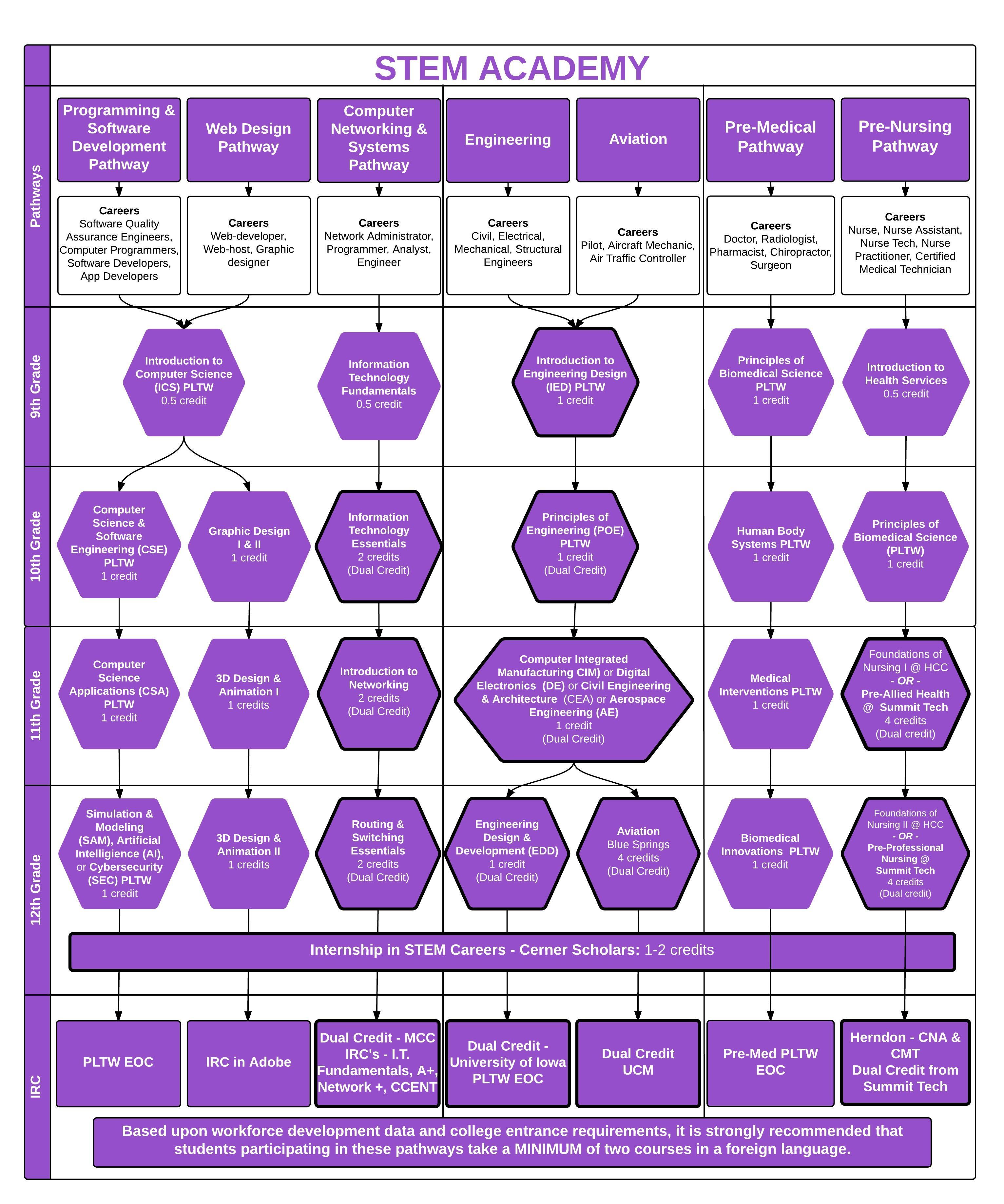STEM Academy: Engineering Pathway

8100: Introduction to Engineering and Design (IED - PLTW) (1 credit PAR, Gr. 9-12, 0.5 weighted)
This course is for students interested in engineering and architecture related fields. Units of study include sketching, multi-views, pictorial and 3-D drawing, sections, dimensions, auxiliary and architectural drawing. Students will be expected to use 2-D and 3-D CAD software to solve problems and present designs. Technical reading and math skills are needed. This course is the first course in the PLTW program. PLTW is a nationally recognized engineering curriculum being offered through the Independence School District. Ask your advisor or guidance counselor about information regarding PLTW or go to www.pltw.org.
8101: Principles of Engineering (POE - PLTW) (1 credit PAR, Gr. 10-12, 0.5 weighted)
Prerequisite: Introduction to Engineering and Design
Recommended Concurrent Courses: Algebra II
This course explores the wide variety of careers in engineering, technology systems, and manufacturing processes. Using activities, projects and problems, students learn first-hand how engineers and technicians use math, science and technology in an engineering problem-solving process to benefit people. PLTW is a nationally recognized engineering curriculum being offered through the Independence School District. Ask your advisor or guidance counselor about information regarding PLTW or go to www.pltw.org.
8119: Computer Integrated Manufacturing (CIM-PLTW) (1 credit PAR, Gr. 11-12, 0.5 weighted)
Prerequisite: Principles of Engineering and Algebra II (or concurrent enrollment)
Recommended Concurrent Courses: General Metals
Manufactured items are part of everyday life, yet most students have not been introduced to the high-tech, innovative nature of modern manufacturing. This course illuminates the opportunities related to understanding manufacturing. At the same time, it teaches students about manufacturing processes, product design, robotics, and automation. Students can earn a virtual manufacturing badge recognized by the National Manufacturing Badge System.
8106: Digital Electronics Engineering (DE-PLTW) (1 credit PAR, Gr. 11-12, 0.5 weighted)
Prerequisite: Principles of Engineering and Algebra II (or concurrent enrollment)
This course is designed so that students gain skills in basic electronics, logical thinking, problem solving, and electronic trouble shooting. Students will seek answers to questions such as how do robots make decisions, how does a calculator work, and what does an electrical engineer do? Digital electronics is so embedded in daily life, from listening to music to withdrawing money from a bank, that it has invaded many other areas of engineering. By gaining a basic understanding of digital electronics in high school, a student gains a head start on an engineering career—no matter what field. Digital Electronics Engineering is a course in applied logic that encompasses the application of electronic circuits and devices. Computer simulation software is used to design and test digital circuitry prior to the actual construction of circuits and devices.
8110: Civil Engineering and Architecture (CEA-PLTW) (1 credit PAR, Gr. 11-12, 0.5 weighted)
Prerequisite: Principles of Engineering and concurrent enrollment in Drawing I or II
The major focus of this course is completing long-term projects that involve the development of property sites. As students learn about various aspects of civil engineering and architecture, they apply what they learn to the design and development of a property. The course provides teachers and students freedom to develop the property as a simulation or to students to model the experiences that civil engineers and architects face. Students work in teams, exploring hands on activities and projects to learn the characteristics of civil engineering and architecture. In addition, students use 3D design software to help them design solutions to solve major course projects. Students learn about documenting their project, solving problems, and communicating their solutions to their peers and members of the professional community of civil engineering and architecture.
8116: Aerospace Engineering (AE-PLTW) (1 credit PAR, Gr. 11-12, 0.5 weighted)
Prerequisite: Principles of Engineering and concurrent enrollment in Physics
This course propels students’ learning in the fundamentals of atmospheric and space flight. As they explore the physics of flight, students bring the concepts to life by designing an airfoil, propulsion system, and rockets. They learn basic orbital mechanics using industry-standard software. They also explore robot systems through projects such as remotely operated vehicles.
8112: Engineering Design and Development (EDD-PLTW) (1 credit PAR, Gr. 12, 0.5 weighted)
Prerequisite: Computer Integrated Manufacturing, Digital Electronics, Civil Engineering & Architecture, or Aerospace Engineering.
This is an engineering research course in which students will work in teams to research, design, and test and construct a solution to an open ended engineering problem. The product development life cycle and a design process are used to guide and help the team to research a solution to the problem. The team presents and defends their solution to panel of outside reviewers at the conclusion of the course.
